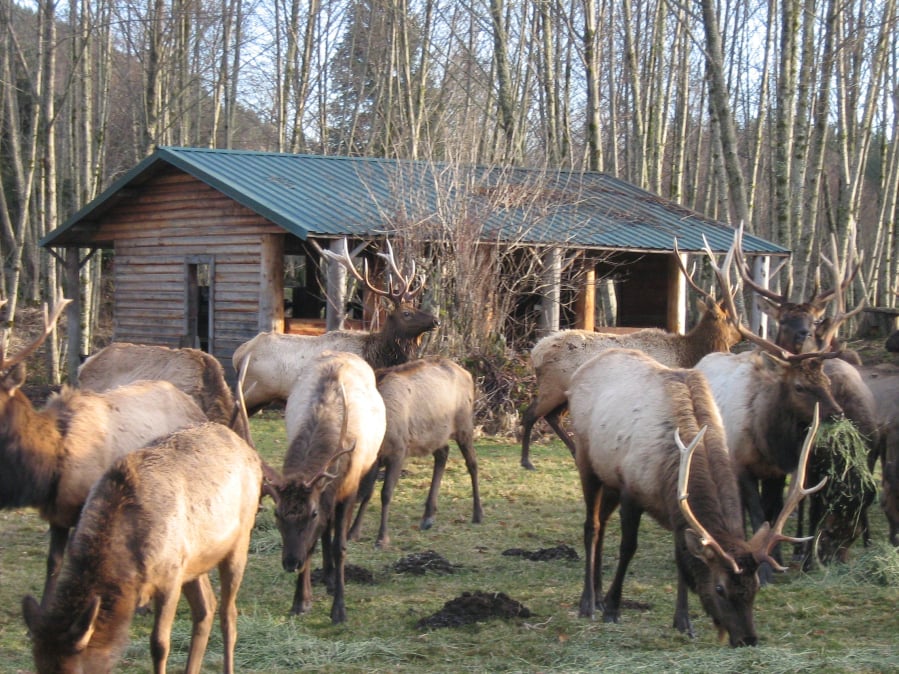Elk hoof disease, also known as Treponema Associated Hoof Disease, (TAHD) continues to spread into new areas. The disease has recently been confirmed for the first time in the state of Idaho, and the Blue Mountains in eastern Washington.
Oregon has also confirmed a number of cases of TAHD.
TAHD has been confirmed in 14 counties in Washington. Washington Department of Fish and Wildlife (WDFW) confirmed the presence of the disease in Klickitat County last spring, the first such find in the state east of the Cascade Range.
The disease causes hoof deformities, which often result in crippling the animals. There is currently no vaccine or treatment available for TAHD.
The outbreak started in Southwest Washington, and is now highly prevalent within the Mount St. Helens and Willapa Hills herds.
The disease has been jumping from region to region, sometimes leaping long distances to pop up in new areas.
When TAHD was confirmed in an elk herd in the Trout Lake area last spring, WDFW staff tried to get control of the spread by removing infected animals.
“The agency strategy was to ID and remove limping elk,” said Kyle Garrison, the WDFW Hoof Disease Coordinator. “We removed four limping elk and sent samples off for testing. The other animals quickly figured out what we were doing. They felt the pressure and left, so we suspended operations.”
He said they continue to monitor the area and have removed another eight animals.
He explained they have worked with landowners and hunters to remove limping elk through agricultural damage hunts.
Montana: In the cross-hairs
Other western states are now wondering if their state will be the next to confirm the disease.
Jennifer Ramsey is a Wildlife Veterinarian with the Montana Fish, Wildlife and Parks Department, and she is understandably worried about the possibility of TAHD showing up in Montana, especially now that it is next door in Idaho.
“It’s something that I am definitely concerned about,” said Ramsey. “Is it already here and we just have not found it yet?”
“We need to be raising the awareness about it, reminding folks what it looks like, and letting them know we want them reporting any limping elk.”
“We don’t yet have a plan in place to respond if we get it,” she added, noting that one will soon be developed. “Right now our plan is looking out for it. Elk hunting has a significant economic impact here. It’s really important in Montana.”
How is the pathogen moving so quickly over such great distances?
Dr. Margaret Wild, hired by the Washington State University College of Veterinary Medicine last year to lead the research efforts into TAHD in the state, addressed that issue recently.
“It’s always an interesting question when a disease spreads,” said Wild. “Has it been there for a while, and did we not diagnose it? How did it arrive? Did it spread from somewhere where it already occurs, from elk to elk, or did it arrive independently?”
The spread of the disease could be aided by human activities, such as the transportation of meat, or motor vehicles, or just about anything.
“We just don’t know,” said Wild. “We can only speculate as to how it got there.”
The new cases appear to throw some doubt on the assumption that TAHD could only spread in moist soils, but Wild is optimistic that studies of captive elk may tease out whether that factor plays a role in the spread of the pathogen.
“It’s a variable that could contribute to how prevalent the disease is,” said Wild.
She reports that the captive elk studies she has planned, which are now moving out of the planning stages, should help scientists figure out which factors do, and don’t, contribute to TAHD.
“We can then ask that question about herbicides, or fertilizers, or wet conditions, or the nutritional status of the animal. These might be contributing factors.”
Herbicides to blame?
Among residents of Southwest Washington that have watched the progression of the disease over the last decade, there has long been an element that has pointed to the heavy spraying of herbicides as a possible factor that they claim scientists have ignored.
The applications are a mix of herbicides that are sprayed over fresh clear cuts on private timberlands to keep down shrubs and other foliage that compete with the young fir trees for nutrients and sunlight.
Mark Smith of Toutle is one of those that thinks herbicide spraying may be to blame.
“The only common denominator in traveling that far is the forest practices that are currently being used,” said Smith.
He said that all the new outbreaks appear to be in areas that are near private timberlands.
“They are not using burning, but using herbicides to clear these areas before planting: killing native species that we don’t know the value of as elk forage,” he added.
Smith and other critics seem to be getting some attention. The Washington legislature is working through a process to establish a board of citizens to look at this problem.
However, Smith said it appears the group will be composed of private timber land representatives, and companies that contract to apply the herbicides.
“I think they are starting a group just so they can say they are investigating it,” said Smith.
Shon Webb of Vancouver is a hunter that is also concerned about the broad application of herbicides and elk health. He thinks hunters need help from another wildlife stake holder.
“We need to get the conservationist involved,” he said.
Webb believes the many wildlife conservation groups could bring some additional weight to bear on wildlife managers to broaden the scope of their research.
He often hunts on private timberlands, and remarks on the sterility of the landscape after spraying.
“There’s no game,” said Webb. “There’s no grouse, there’s no rabbits, there’s no birds. There’s no game at all.”




